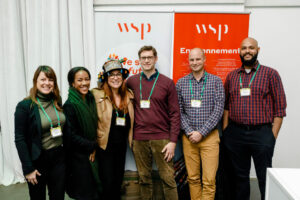Wednesday, July 2, 2025
Soils play a key role in sustaining ecosystems that are vital for human health and that are used for a number of products and services in Canada. Healthy soil stores carbon and supports a landscape that is more resilient to the impacts of drought, flood, or fire.
The amount of excess soils generated from construction and cleanup projects has grown significantly over the past decades. For example, an estimated 25 million cubic metres of excess soil is generated in Ontario every year. That means that the excavated soil in Ontario could fill 16 Rogers Centres annually.
While most excess soil can be reused safely, some excess soil may have limited levels of contaminants and care must be taken when determining where it may be reused.
With this in mind, the 6th Annual Excess Soils Symposium was held on December 6th at The Warehouse Venue in Toronto. More than 250 attendees included ministry representatives, municipal staffers, construction developers, industry stakeholders, engineers, project managers, qualified professionals, fill site operators, media and more.
The symposium offered an interactive update on the business of excess soils and new regulations impacting construction and cleanup projects. The comprehensive conversations provided a multi-stakeholder approach on new developments, including perspectives on land use planning, building issues, environmental impacts, and disposal costs related to new regulations.
This year, the in-person format provided participants with an opportunity to catch up with colleagues, and at the end of the day, enjoy some live music together. Attendees were also invited to participate in the online Whova platform which provided details about the attendees, the program, and several opportunities for instant messaging, resource sharing and networking.
More than 250 people registered for the 2022 Excess Soils Symposium, which was held at The Warehouse Venue in Toronto, Ontario.
There was a buzz in the room about the impending end of the pause on Ontario’s excess soil regulation. In April 2022, to help give developers and municipalities more time to better understand their responsibilities under the regulation, the Ontario Ministry of Environment, Conservation and Parks paused the implementation of the provisions that came into effect on January 1, 2022, until January 1, 2023, including provisions related to registration, sampling and analysis and tracking of excess soil.
There were some clear themes that arose throughout the day, including the importance of regulation awareness, early and integrated project planning, the importance of involving a Qualified Person (QP), and the need for increased communication of solutions that will help Ontario industry adapt, and also help inform jurisdictions across the country who are dealing with the same challenges.

Some of the 250+ attendees enjoying a coffee and some networking time, from left to right: Kam Chan of Matrix Solutions Inc., Dave Wong of EnVision Consultants Ltd., Duncan McKinnon of ALS, and Ryan Moniz of GFL Environmental.
When attendees were polled about their biggest challenges with excess soils management, the majority of votes (41 per cent) were for “The gaps in knowledge about new regulations,” whereas “A lack of strategic preparation and project management” was selected by 29 per cent, “The cost of compliance” was selected by 17 per cent, and “Limited resources to apply best practices to streamline resource recovery,” was selected by 13 per cent.
To get the conversation started, Corinne Lynds, content director of Actual Media, and Connie Vitello, editor of Environment Journal, welcomed attendees to the symposium with some introductory remarks.
“It’s great to see so many of you here today at this sixth annual Excess Soils Symposium, and great to be back to an in-person format. There are many familiar faces and some news ones as well,” said Lynds.
“I’m excited for our incredible line-up of speakers, including policymakers and experts in the industry,” added Vitello. “We can confidently say you’re in for a comprehensive and valuable overview that will provide you with a strategic edge entering the new year.”
They set the stage, outlining the main reasons for the important discussions to follow: recovering this valuable resource could save municipalities a substantial amount of money, the environmental impact is undeniable as greenhouse gas emissions are produced by platoons of trucks travelling on roads, and those roads are incurring a lot of wear and tear, which means funds have to be spent on infrastructure repairs sooner than if these trucks were using them less.
Kevin Goldberg, president of SoilFLO, helped kicked off the symposium with a poignant talk on the evolution of the industry and his personal perspective on the significant changes and new regulations and policy impacting excess soil management.
“Our industry has gone through generational change, an evolution of change in regulation, technology, and attitude,” said Goldberg. “The way we used to do it was not necessarily wrong, but we have learned, assessed the risks and developed new ways of doing things. As we are now aware of some of the dangers that face the way we do things, we have developed better ways and will continue to learn even better ways as we move forward.”
He attributed the “dozens of stakeholder meetings, industry consultations, millions of dollars of investment, countless hours by Ministry Staff and even volunteer hours of local non-profits” with finally having “a regulation that works, is good for business and the environment.”
How has this change manifested itself in his business?
“Since January 1, we have tracked over seven million cubic metres on SoilFLO for compliance with the tracking requirements of O.Reg 406/19. Better yet, these loads have gone for beneficial reuse to quarries, developments, municipal construction, lakefills and habitat restorations. Not only are these projects properly tracking their soil, but they are also doing the proper reporting and testing,” explained Goldberg.
He said they have seen the largest companies in our industry invest millions in changing their processes to meet the new gold standard. And we have seen the smallest ones take the time to understand what this regulation means for them and take the appropriate actions to be compliant as well.
“We at SoilFLO have seen the benefits of this regulation firsthand,” said Goldberg. “The transparent market is reducing travel distances. Opening up fill sites. And making Municipalities and landowners more comfortable with the concept of reusing soil. Owners are taking more pragmatic approaches to soil management and investing in smarter ways of doing old processes.”
The Honourable David Piccini, Ontario’s Minister of Environment, Conservation and Parks was not able to attend in person, but he was keen to provide a video address in support of the symposium and in support of the responsible management of excess soils.
“Ontario is experiencing tremendous growth, within the next 20 years Ontario will be home to an additional 4.2 million people. Together, we’re building the critical infrastructure needed to support a growing population,” said Minister Piccini. “Your industry has provided valuable insight about how to effectively manage excess oils that we generate each and every year.”
According to Minister Piccini, the ministry is actively reviewing the excess soils regulation “to ensure that we’re doing the right thing: that we’re reducing the amount of reusable soil going to landfills while continuing to encourage responsible management of contaminated soils.”
“This is so important as together we continue to grow in the province of Ontario and as we work together to ensure we’re responsive the needs of rural communities like mine,” he said. “Together we’re working to reduce the burden of red tape on project leaders, builders and qualified professionals and you’ve been part of that important discussion.”
“Thank you to the Environment Journal for organizing today’s important event. I thank you all for your hard work to build healthier and prosperous communities in the province of Ontario. Together we work to foster economic prosperity for all Ontarians,” concluded Minister Piccini.
The keynote presentation was delivered by Peter Sutton, VP of environmental services with Terrapex. Sutton provided an experienced perspective on the new reality for land use, soil disposal or treatment, and resource recovery policies in 2023 and beyond.
“It looks like we are set to have the majority of this regulation [O.Reg. 406/19] in force in less than a month. That’s big news for Ontario and the management of excess soils,” said Peter Sutton.
“I vehemently believe this regulation has the ability to improve they way we’ve been managing soils. We now have a tool that will help us all do better, but we’re at a fork in the path.”
Sutton ended his keynote with a call to action for the Ontario ministry to apply more resources to help achieve best outcomes moving forward.
Regulation Roundup
The first panel provided an expert overview of new excess soils regulations across the country. The overall purpose of Excess Soil Regulations is to protect land by taking steps to properly manage local soil, ensure valuable resources are not wasted, reduce the risk of contaminants, reduce GHG emissions, and help redevelop brownfields and other development sites.
Moderator Corinne Lynds facilitated the panel conversation with: Mark Adamson of WSP Canada; Janet Bobechko of WeirFoulds LLP, who is on the Provincial Excess Soil Engagement Group (MECP); Matt Gardner of Willms & Shier Environmental Lawyers LLP; and, Denise Lacchin, WSP Golder, Qualified Persons Community of Ontario (QPCO) – Excess Soils Working Group Member.
New excess soil regulations for Ontario are being phased in over several years, giving affected municipalities and contractors more time to prepare for the registry portion of the province’s soil regulations. The regulations were launched in 2019, and the pause will be over on January 1, 2023.
Are we ready?
“Sort of,” answered Bobechko. “There’s still a lot to do to improve knowledge sharing and prepare the industry, but it’s a team effort: I rely on my QPs. It’s a complex regulation. We’re working together and we all have a goal in mind, to do things the right way, with the ministry as a partner.”
She emphasized the importance of best management practices and protecting yourself through contracts and due diligence, documenting, and assigning detailed roles of responsibility, with the QP as gatekeeper.
The Regulatory Roundup Panel, from left to right: Mark Adamson of WSP Canada; Denise Lacchin of WSP Golder; Janet Bobechko of WeirFoulds LLP; and, Matt Gardner of Willms & Shier Environmental Lawyers LLP.
“It’s a big misconception that the whole thing is on pause,” said Gardner. “This regime has been in effect for many months now and that’s important for everyone to know. On January 1, the rubber hits the road.”
The B.C. government has also released the proposed changes to the Contaminated Sites Regulation under the province’s Environmental Management Act. Once it comes into force, on March 1, 2023, how will these new rules extend regulatory requirements to uncontaminated soil?
“One of the differences is the focus on activity on the land. That is going to be captured in excess soil tracking process,” explained Adamson. “Something that our climate change ministry is pushing is transparency with neighbours and Indigenous communities.”
He also explained that there will be a two tier system for large receiving facilities, for commercial quality soil versus industrial quality soil.
What’s the industry feedback on the Ontario excess soil registry so far? Phase three was scheduled to begin in 2025. Do you think there will be any additional pauses?
“The regulation is complicated and it’s not a cookie cutter,” said Lacchin. “So it’s important to look at every project as a unique case. Soil is a valuable resource and we want to make sure it’s reused if possible.”
There was further discussion about the importance of getting planning documents underway and determining whether a project is registerable, just a couple of the key issues a QP and excess soils specialist can help with.
It also became clear there have been lessons learned in developing the Ontario regulations. Experts noted that Quebec has also been ground-breaking with regard to its soil laws, particularly with regard to petrocarbon contamination. In some ways, the lessons learned in Ontario, Quebec and now B.C. will serve other jurisdictions in Canada, such as the east coast, remote communities, and northern Canada.
Excess soils across the country
To provide a quick snapshot of excess soil voices from across the country, a new video was premiered. The multimedia experience of ESS continued with the Meggen Janes of Geostyntec presenting a diverse look at excess soils management, including Indigenous Peoples and French-speaking participants.
The video, “The New Era in Excess Soils: A Look at Leadership in Resource Recovery Across Canada is available here. Many of the “soil stars” were in attendance at the Symposium.
To view the well received video, click here.




The exhibit spaces were well attended throughout the lunch and breaks.
Best industry practices
This second panel offered senior-level insights into how industry stakeholders are actually adapting. Practical strategies can help industry adapt business plans and budgets with regard to hauling, temporary site use, and targeted excess soil management plans that treat soils as a valuable resource rather than a waste material. It’s no small task changing how a whole industry interacts with previous policy. But these industry experts are helping spread the word and sharing the messages here at ESS and going forward. There are going to be gaps in soil movement but best practices can continue to evolve and address the gaps in time.
Moderator Andy Manahan of Manahan Consulting Services was joined by: Sanjay Coelho from the Ministry of Environment, Conservation and Parks; Ryan Moniz of GFL Environmental; Grant Walsom of XCG Consulting Ltd. and Chair of QPCO, co-Leader of QPCO Excess Soil Working Group (and former co-Chair of ONEIA Excess Soil Working Group); and, Freesia Waxman, Grounded Engineering and Qualified Person.
How is the Ontario government managing industry reaction to new Excess Soil Regulation? What are some sources of education you recommend to keep us informed of updates?
“We’re looking to have fluid lines of communication with industry,” said Coelho, who explained that the excess soils engagement group, which includes municipal and industry representatives, has met about 15 times, in addition to several other meetings and phone calls. Coelho also pointed to a variety of resources, including fact sheets and webinars that are helpful for updates on the regulations, amendments and best practices.
The ministry developed the excess soil fact sheets to help explain requirements under the regulation. Fact sheets are available through the excess soil fact sheet web page. (Note: these fact sheets are for information purposes only and should not be construed as legal advice. They are not a substitute for seeking independent legal advice on any issues related to the regulation.)
Best Industry Practices Panel, from left to right: Andy Manahan of Manahan Consulting Services; Ryan Moniz of GFL Environmental; Freesia Waxman, Grounded Engineering and Qualified Person; Sanjay Coelho from the Ministry of Environment, Conservation and Parks; and, Grant Walsom of XCG Consulting Ltd.
Walsom recommends having a look at the Canadian Council of Ministers of the Environment (CCME) guidelines that were recently posted for comments until January. “This is a nice tool for the toolbox and I recommend looking at it.”
Walsom advises that when it comes to best practices in excess soils management, “early planning helps align projects.” He also encourage project managers to maximize opportunities for local reuse of excess soils and minimizing hauling offsite.
How are construction companies changing the way they manage excavated materials? How are major projects rethinking their practices?
“This massive regulation has been rolling out all the distractions of working from home,” said Moniz, who recently welcomed twins into his life. “It’s important to get up to speed. You don’t want to be the first person to have the precedent setting excess soil case of non-compliance.”
He advises that QP engagement is key.
Moniz said that with regard to major projects, such as the transportation tunneling projects that involve soil mixed with rock, building muck pits and onsite reuse options is critical.
Waxman emphasized the importance of asking key questions. “Once you hire the QP, do you need a soil management plan? Are you going to generate liquid soil? Walk through how it will be staged? What’s the timing for all of this? Answering these kinds of questions gets you far ahead in the game.”
Innovative initiatives
The final panel explored elevated strategies, and new solutions through cleantech and digital tracking. This high-level discussion provided insight into how industry leading companies and consultants are incorporating efficiencies and new tech to deliver cost savings and achieve successful outcomes.
Moderator: Todd Latham of Actual Media Inc. engaged the following panelists: Krista Barfoot of the Canadian Brownfields Network; Meggen Janes of Geosyntec Consultants; Monisha Nandi of Kilmer Brownfield Management Ltd.; Kevin Goldberg of SoilFLO; Bruce Tunnicliffe of Vertex Environmental Inc.
When polled about what new and innovative practice or technology is assisting attendees in their excess soil endeavours, 52 per cent selected “Better advanced strategic planning” while 36 per cent credited “Software programs that aid with soil tracking and regulation adherence” with the rest of the votes going to “Improvements to drilling and sampling procedure” and “Other”.
Innovative Initiatives Panel, from left to right: Todd Latham of Actual Media Inc.; Kevin Goldberg of SoilFLO; Monisha Nandi of Kilmer Brownfield Management Ltd.; Krista Barfoot of the Canadian Brownfields Network; Meggen Janes of Geosyntec Consultants; and, Bruce Tunnicliffe of Vertex Environmental Inc.
As someone who has worked on governmental and private projects as a consultant and project leader, Janes pointed out the importance of fiscal responsibility and beneficial reuse. “I want to call it ‘recycling soil’. Top soil is soil on high octane.”
What best practices do you see from a site strategy or strategic site planning perspective that help drive successful implementation of excess soil regulations?
Early engagement is so important, especially if you want a site-specific permit,” said Tunnicliffe. “It’s hard to be innovative at the last minute.”
“Project leaders need clear contact language,” stated Nandi. “Over the last year, during this pause, we have seen, in practice, an improved understanding of what is required through tracking perspective. All of the changes and the pauses and new exemptions don’t help, but we’re very quickly getting to a place where that is consistency in terms of standard reporting.”
Nandi emphasized the importance of building project teams that have many disciplines of expertise – including environmental, geotechnical, structural, hydrogeology – that are given the mandate to think outside of box. “No one can design strategically in a silo.”
Barfoot concurred with Nandi. “The constructor should be involved early in the process and it’s on us to look for new solutions and bring those to clients. This is a great advantage for most projects. I like to encourage whole project planning versus addressing steps in discreet pieces.”
What best practices and newest technologies are being utilized to address gaps and to reduce the environmental cost of reusing or disposing excess construction soils?
“We’re doing great and making good progress with the regulation,” said Goldberg. “The onus is also on the innovator – you have to do the business development legwork so a big part of it is getting in front of the right people and showing them the benefits.”
“At the root of all of this is sustainability, and we’re at a watershed moment,” said Tunnicliffe, who reminded participants that there are currently only six cities in all of Canada that have a population of over one million, but that Canada is welcoming approximately 600,000 people every year. His comments circled back to the Minister’s remarks about building new homes to accommodate new Ontarians – while responsibly managing natural resources.
Following the panel presentations guest enjoyed live entertainment and some time to discuss the perspectives of the day and catch up with colleagues in the industry.






Videos of the complete panel conversations will be available in the new year. Stay tuned. For a link to further information about the event and the panelists, please click here.
Featured image of Queensville Pits by Conrad McGovern of Rice Aggregates.




















